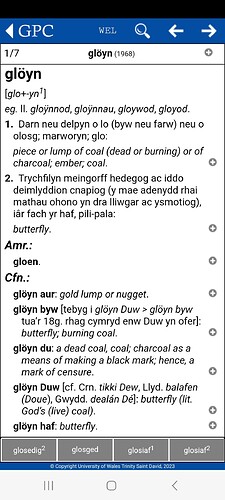Excellent question! And I don’t know of a definitive reason, but I know cwch and bad are both used for smaller vessels (boats) whilst llong is for larger vessels (ships) - and to be honest, I don’t know at what criteria a boat becomes a ship in English either!
Sometimes cwch and bad are interchangeable - you can hear both cwch rhwyfo and bad rhwyfo for ‘rowing boat’, but other times I think it’s one or the other just by traditional usage - I may be wrong, but I think bad in particular referred to uncovered vessels, so original rescue boats would have been open row boats and so were called badau achub, and even though modern rescue boats have evolved to be more like cychod, the original name stuck.
I sometimes have that experience after an evening in the Llew Du…
If you could get the Devonians next door to annex you, it could then be referred to as Dwyrain Dyfnaint, couldn’t it? Once Greater Cymru had been restored of course.
Syniad da, @garethrking! Er roedd Shaftesbury - lle dwi’n byw - yn arfer nabod fel Caer Paladwr, medden nhw… (please feel free to correct my Cymraeg as required!)
I think we would have to rejig this one:
Er mai Caer Paladwr oedd yr enw ar Shaftesbury gynt, medden nhw ![]()
I think we would have to rejig this one:
Er mai Caer Paladwr oedd yr enw ar Shaftesbury gynt, medden nhw
Aha. Diolch. I had a nasty feeling I was a little astray. Could that mai be a taw? I shall have to find out about gynt…
Yes it could, in equatorial regions.
You can just learn the adverb gynt as a one-off, meaning formerly. ![]()
Yes it could, in equatorial regions.
Equatorial regions ![]() Yep, that’ll be me. Rock solid hwntw…
Yep, that’ll be me. Rock solid hwntw…
So, on the subject of species names…
I was trying to work out how to say “clouded yellow butterfly”. Off the cuff the best I could do was pilipala felyn cwmylog. I know that cwmylog means cloudy, but I don’t know how one might say clouded?
Secondly… the exercise opened my eyes to the glorious range of words for butterfly. Iâr fach yr haf is wonderful; so is glôyn byw. Which one would be most commonly used in the south?
It’s best not to try and translate species names literally. ‘clouded yellow’ in terms of a butterfly is llwydfelyn (literally ‘grey-yellow’)
So -
Clouded Yellow = Colias croceus = llwydfelyn
Berger’s Clouded Yellow = Colias alfacariensis = llwydfelyn Berger
Moorland Clouded Yellow = Colias palaeno = llwydfelyn y rhos
Pale Clouded Yellow = Colias hyale = llwydfelyn gwelw
You might find this site handy for naming nature (it’s the one I use) Llên Natur: Gwefan Natur i Bobl Cymru - Y Bywiadur
As for Southern usage, I think you’ll hear just as many of each and it’ll vary more to immediate locality or personal preference rather than a clear cut ‘mostly S’ or ‘mostly N’.
According to GPC, glöyn byw - which I think of in terms of the old fashioned English word as “living glede”, because “living live coal” sounds a bit silly - is probably altered from earlier glöyn Duw (“God’s glede”) to avoid taking the Lord’s name in vain.
Bore da! Yes, I kind of knew that… but however wrong it might be, the question has opened up new areas of knowledge ![]()
So… thank you for llwydfelyn. Curiously enough I saw that word on my bee wall chart (cacynen cynfffon lwydfelyn, or Bombus Terrestris) and managed to extract “grey-yellow” but didn’t follow it up. Now it’s come back to me in the form of a butterfly. Thanks for the link to Y Bywiadur ![]()
Hello @RichardBuck … I looked up glöyn in the Gweiadur and it offered me “ember”. I think the simile is lovely - likening butterflies to flying, living sparks, perhaps ![]()
Yup - same thing, a live coal. I think I just like glede because it (a) sounds like Tolkien; and (b) is actually distantly related to glo ![]()
Can I ask another? For “wing” (of a bird, dragon or aeroplane) is there any difference between asgell and adain?
Only that I think adain is more common for a ‘flight’ wing. GPC lists both as this type of wing, whereas GyA lists both but says asgell is less correct and more occasional (though used, nonetheless). Asgell is more commonly used for other types of ‘wing’ (buildings, military, sports).
Bore da @siaronjames, a diolch. That’s the conclusion I was tentatively reaching.
Ages ago I was looking for ways to say “showing off” (dangos fy hun) but also came across the phrase lledu fy hesgyll “spread my wings” - which resulted in my associating “wing”, in all senses, with asgell. I also met asgell in the military/sporting sense while trying to learn some rugby terminology, where I learned asgellwyr and blaenasgellwyr (“wingers” and “flankers”).
It was only my sudden interest in bees and butterflies that brought adain to light!
Diolch yn fawr, eto.
Yes - about a woman, Hi ydy’r dala; to a woman, Ti ydy’r dala ![]()
Soz, Sara - yes, it’s going to be dala for a woman whatever. I would say of myself Fi ydy’r tala, while you would say of yourself Fi ydy’r dala. ![]()
My brother in New Brunswick, Canada, sent me information he had found on old hotels with Welsh names: “In the 1880’s Campobello [Island] sported three of the most elegant hotels on the Atlantic coast. TYN-Y-MAES HOTEL…(that’s Welsh for house in the field)…the Owen and the Tyn-Y-Coed.” Is ‘Tyn-y-’ a written corruption of ‘Tŷ-yn-y.’? (The adjective ‘tyn’ - strained, tight - appears irrelevant!)
